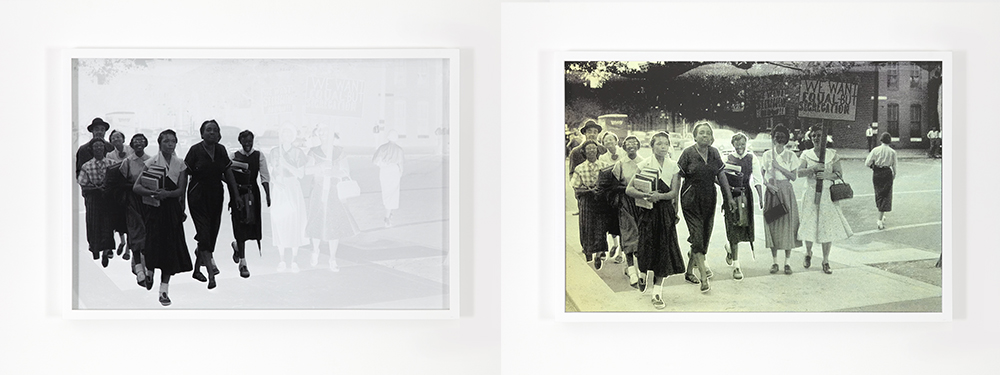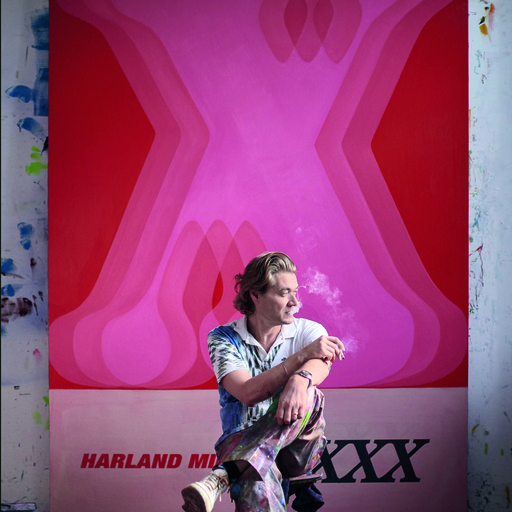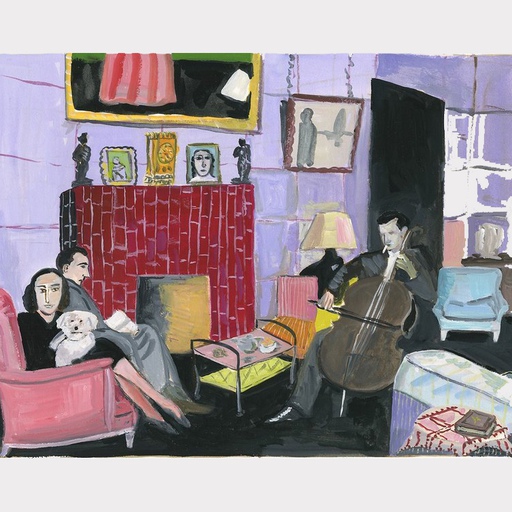There are relatively few artists who can achieve two things simultaneously within a work: one, to make a statement that is easily understood by a wide audience (and not only insiders with a knowledge of art history); and two, to not make a work that is so literal and so obvious that it lacks critical depth and artistic subtlety. Hank Willis Thomas has made a name for himself doing exactly these two things.
Thomas’s mother, Debora Willis, is a curator, photographic historian, educator, and author—so the artist grew up between the aisles of university libraries. It’s no surprise, then, that Thomas’s process often starts with theoretical research and a deep dive into historic archives of photos, magazines, and ephemera, to unearth material for his work.
For the exhibition “What We Ask Is Simple,” currently spanning both Jack Shainman galleries in Chelsea, Thomas sifted through archival images of people protesting around the world from the 1910s to 1970s. “These images are what the theorist Roland Barthes calls Punctum—images that for one reason or another, really stick with you.” For Thomas, these images of protest not only “stick with us”—they show us that the struggle for human rights is never ending. “Throughout history people have always had to fight for human rights. Human rights are never given.”
 We want equal - but...(II)
, 2018. Left: without flash. Right: with flash. Images courtesy of the artist and Jack Shainman Gallery.
We want equal - but...(II)
, 2018. Left: without flash. Right: with flash. Images courtesy of the artist and Jack Shainman Gallery.
The viewer isn’t off the hook either—we have to put in a little work to see every facet of the works on view in “What We Ask Is Simple.” “The viewer becomes part of the work,” Thomas tells Artspace over the phone. “They become participants.” Upon entering the gallery, an attendant will hand you a pair of glasses equipped with flashlights facing outward. The gallery is dimly lit. On the walls are the aforementioned protest photographs screen printed retroreflective vinyl, mounted on Dibond using a carefully composed combination of normal ink, and a special reflective ink typically used for stop signs and hazard warnings. When We want equal – but…(III) is unlit, for example, we see a group of smiling Black American young women walking down the street carrying schoolbooks, presumably on their way to school. The rest of the composition—which includes two white women holding signs saying things like “WE WANT SEGREGATION NOW!”—is revealed to us only when we literally “shine a light” on the subject. The struggle is real, but you have to be willing to look for it.
 Freedom for Soweto (white wash)
. Left: without flash. Right: with flash. Images courtesy of the artist and Jack Shainman Gallery.
Freedom for Soweto (white wash)
. Left: without flash. Right: with flash. Images courtesy of the artist and Jack Shainman Gallery.
“In the retroflective works, I’m trying to illuminate stories and parts of history that often get overlooked,” says Thomas. In Freedom for Soweto (white wash) , we see a young black man standing peacefully with outstretched arms signaling the peace sign. When illuminated, the rest of the scene is disclosed: men in riot gear surround the young man, as an aggressive dog lunges towards him. In Don’t Let Us Down , a group of men sitting in wheel chairs face the camera holding signs. The signs, which advocate for disabled vets, are illegible, until the piece is activated by the viewer’s shining light. (They read: “Keep Faith With Disabled Vets,” “How About a Brooklyn VA Hospital,” and “Don’t Let Us Down.”)
 Don't Let Us Down
. Left: without flash. Right: with flash. Images courtesy of the artist and Jack Shainman Gallery.
Don't Let Us Down
. Left: without flash. Right: with flash. Images courtesy of the artist and Jack Shainman Gallery.
Full disclosure, when I went to the opening of “What We Ask Is Simple,” I didn’t wait in line for a pair of special flash-light-glasses. (An attendant informed me that using the flash on my phone would work just as well.) Using my iPhone to illuminate the work, I found myself in a familiar situation: mediating an experience through the use of my device. Using my phone’s camera I took pictures of the works, experimenting with turning the flash on and off, and my position and angle in relation to the wall. If the social activist photographers of decades past initially recorded the images on view, and Thomas reinterpreted them as art relevant in 2018, I, the viewer, was re-imaging them a third time, and with the potential to proliferate them infinitely by sharing them to my Instagram feed. Beyond the work itself, the experience of the work opened up conversations about how we see images in today's world. Hank’s series illustrates that protest and struggle have always been a part of human history. It also illustrates how drastically our relationship to images have changed, now that we have access to them all at once in our pocket at all times.
“We’re constantly scrolling past photographs on social media,” Thomas tells Artspace. “And we’re trained to look at the most amount of images in the least amount of time possible. This hyper-consumption of photography is limiting our ability to look closely.” Though Thomas’s works in some ways encourage the viewer to photograph them (and post them to social media), they also ask us “to slow down and consume the images at a slower pace than we’re used to,” says Thomas.
Thomas’s interest in social and political resistance isn’t confined to the reflective surfaces of his works. In 2016 he and a collaborator, Eric Gottesman, started For Freedom’s, an artist-run Super PAC. They're currently unrolling a project they hope will reach all 50 states, and it encourages people all over the country to produce artist-made billboards, hold town hall meetings, and host art exhibitions. “I don’t want to express my opinions as much as I want to allow for others to voice their concerns,” says Thomas. “Brands give answers. I’d rather ask questions.”
























